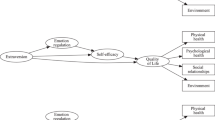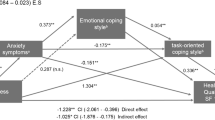Abstract
Purpose
The aim of this study was to test a model proposing that the relationship between personality factors and women’s quality of life (QoL) is mediated by degree of depression and the way in which every day activity and general health were appraised. Specifically, the paper addressed the mediating contribution of activity.
Methods
A sample of 488 women, 38 or 50 years old, filled out questionnaires regarding the target variables. The personality traits measured were extraversion and neuroticism, and the activity aspect addressed was the value linked with everyday activities. Additionally, general health and depressive state was rated. Structural equation modeling was used to analyze the data.
Results
A model was found where health, activity and depressive state mediated the association between personality and QoL. Health explained in total nearly 30% of the variation in QoL. Activity predicted 12% of the variance in QoL, partly as a unique factor and partly mediated by depressive state and health. Extraversion was linked to QoL only through activity, and neuroticism through depressive state and health.
Conclusions
Our analysis supported that there was a link between personality and QoL and that perceived general health was an important contributor to QoL. Moreover, it contributed new knowledge regarding the importance of valued and satisfying activities. If this proves to be a consistent finding in future studies, including intervention research, monitoring women’s daily activities might be a pathway to improved QoL.


Similar content being viewed by others
Notes
The estimations were repeated using the scale-free least square discrepancy function. The standardized coefficients revealed the same pattern. Small differences were found for the paths to QoL from Activity (0.29), Depression (−0.33) and Health (0.44).
References
Undén, A. L., Elofsson, S., Andreasson, A., Hillered, E., Eriksson, I., & Brismar, K. (2008). Gender differences in self-rated health, quality of life, quality of care, and metabolic control in patients with diabetes. Gender and Medicine, 5(2), 162–180.
Wijnhoven, H. A., Kriegsman, D. M., Snoek, F. J., Hesselink, A. E., & de Haan, M. (2003). Gender differences in health-related quality of life among asthma patients. Journal of Asthma, 40(2), 189–199.
Bingefors, K., & Isacson, D. (2004). Epidemiology, co-morbidity, and impact on health-related quality of life of self-reported headache and musculoskeletal pain—a gender perspective. European Journal of Pain, 8(5), 435–450.
Norris, C. M., Ghali, W. A., Galbraith, P. D., Graham, M. M., Jensen, L. A., & Knudtson, M. L. (2004). Women with coronary artery disease report worse health-related quality of life outcomes compared to men. Health and Quality of Life Outcomes. http://www.hqlo.com/content/2/1/21.
Röder-Wanner, U. U., Oliver, J. P., & Priebe, S. (1997). Does quality of life differ in schizophrenic women and men? An empirical study. International Journal of Social Psychiatry, 43(2), 129–143.
Gallicchio, L., Hoffman, S. C., & Helzlsouer, K. J. (2007). The relationship between gender, social support, and health-related quality of life in a community-based study in Washington County, Maryland. Quality of Life Research, 6(5), 777–786.
Kitamura, T., Kawakami, N., Sakamoto, S., Tanigawa, T., Ono, Y., & Fujihara, S. (2002). Quality of life and its correlates in a community population in a Japanese rural area. Psychiatry and Clinical Neurosciences, 56(4), 431–441.
Hultman, B., & Hemlin, S. (2008). Self-rated quality of life among the young unemployed and the young in work in northern Sweden. Work, 30(4), 461–472.
Redondo-Sendino, A., Guallar-Castillon, P., Banegas, J. R., & Rodriguez-Artalejo, F. (2006). Gender differences in the utilization of health-care services among the older adult population of Spain. BMC Public Health. doi:10.1186/1471-2458-6-155.
Nygren, C., Iwarsson, S., & Dehlin, O. (2000). Exploration of subjective well-being and dependence in daily activities at the beginning of the geriatric rehabilitation process: a challenge to traditional goal-setting and evaluation procedures? Archives of Gerontology and Geriatrics, 30(3), 173–184.
Penedo, F. J., Gonzalez, J. S., Dahn, J. R., Antoni, M., Malow, R., Costa, P., et al. (2003). Personality, quality of life and HAART adherence among men and women living with HIV/AIDS. Journal of Psychosomatic Research, 54(3), 271–278.
van der Steeg, A. F., De Vries, J., van der Ent, F. W., & Roukema, J. A. (2007). Personality predicts quality of life six months after the diagnosis and treatment of breast disease. Annals of Surgical Oncology, 14(2), 678–685.
McCrae, R. R., & Costa, P. T. J. (1999). A five-factor theory of personality. In L. Pervin & O. P. John (Eds.), Handbook of personality: Theory and research (pp. 139–153). New York: Guilford.
Ramanaiah, N. V., Detwiler, F. R., & Byravan, A. (1997). Life satisfaction and the five-factor model of personality. Psychological Reports, 80(3), 1208–1210.
van Straten, A., Cuijpers, P., van Zuuren, F. J., Smits, N., & Donker, M. (2007). Personality traits and health-related quality of life in patients with mood and anxiety disorders. Quality of Life Research, 16(1), 1–8.
Schimmack, U., Oishi, S., Furr, R. M., & Funder, D. C. (2004). Personality and life satisfaction: a facet-level analysis. Personality and Social Psychology Bulletin, 30(8), 1062–1075.
Law, M., Steinwender, S., & Leclair, L. (1998). Occupation, health and well-being. Canadian Journal of Occupational Therapy, 65(2), 81–91.
Eklund, M., & Leufstadius, C. (2007). Relationships between occupational factors and health and well-being in individuals with persistent mental illness living in the community. Canadian Journal of Occupational Therapy, 74(4), 303–313.
Rüesch, P., Graf, J., Meyer, P. C., Rössler, W., & Hell, D. (2004). Occupation, social support and quality of life in persons with schizophrenic or affective disorders. Social Psychiatry and Psychiatric Epidemiology, 39(9), 686–694.
Eklund, M., & Bäckström, M. (2005). A model of subjective quality of life for outpatients with schizophrenia and other psychoses. Quality of Life Research, 14(4), 1157–1168.
Erlandsson, L.-K., & Eklund, M. (2003). Women’s experiences of hassles and uplifts in their everyday patterns of occupations. Occupational Therapy International, 10(2), 95–114.
Erlandsson, L.-K., & Eklund, M. (2003). The relationships of hassles and uplifts to experience of health in working women. Women and Health, 38(4), 19–37.
Erlandsson, L.-K., & Eklund, M. (2006). M. Levels of complexity in patterns of daily occupations: relationships to women’s well-being. Journal of Occupational Science, 13(1), 27–36.
Håkansson, C., Lissner, L., Björkelund, C., & Sonn, U. (2009). Engagement in patterns of daily occupations and perceived health among women of working age. Scandinavian Journal of Occupational Therapy, 16(2), 110–117.
Daley, A., Macarthur, C., Stokes-Lampard, H., McManus, R., Wilson, S., & Mutrie, N. (2007). Exercise participation, body mass index, and health-related quality of life in women of menopausal age. British Journal of General Practice, 57(535), 130–135.
Ware, J. E., Jr., & Sherbourne, C. D. (1992). The MOS 36-item short-form health survey (SF-36). I. Conceptual framework and item selection. Medical Care, 30(6), 473–483.
Priebe, S., Huxley, P., Knight, S., & Evans, S. (1999). Application and results of the Manchester short assessment of quality of life (MANSA). International Journal of Social Psychiatry, 45(1), 7–12.
Tibblin, G., Tibblin, B., Peciva, S., Kullman, S., & Svardsudd, K. (1990). “The Goteborg quality of life instrument”—an assessment of well-being and symptoms among men born 1913 and 1923. Methods and validity. Scandinavian Journal of Primary Health Care, 1, 33–38.
Kieffer, J. M., & Hoogstraten, J. (2008). Linking oral health, general health, and quality of life. European Journal of Oral Sciences, 116(5), 445–450.
Karakoyun-Celik, O., Gorken, I., Sahin, S., Orcin, E., Alanyali, H., & Kinay, M. (2009). Depression and anxiety levels in woman under follow-up for breast cancer: relationship to coping with cancer and quality of life. Medical Oncology [Epub ahead of print].
White, M. L., & Groh, C. J. (2007). Depression and quality of life in women after a myocardial infarction. The Journal of Cardiovascular Nursing, 22(2), 138–144.
Conde, D. M., Pinto-Neto, A. M., Santos-Sa, D., Costa-Paiva, L., & Martinez, E. Z. (2006). Factors associated with quality of life in a cohort of postmenopausal women. Gynecological Endocrinology, 22(8), 441–446.
Norris, C. M., Hegadoren, K., & Pilote, L. (2007). Depression symptoms have a greater impact on the 1-year health-related quality of life outcomes of women post-myocardial infarction compared to men. European Journal of Cardiovascular Nursing, 6(2), 92–98.
Kendler, K. S., Gatz, M., Gardner, C. O., & Pedersen, N. L. (2006). Personality and major depression: a Swedish longitudinal, population-based twin study. Archives of General Psychiatry, 63(10), 1113–1120.
Dijkstra, P., & Barelds, D. P. (2009). Women’s well-being: the role of individual differences. Scandinavian Journal of Psychology, 50(4), 309–315.
Eklund, M., Hansson, L., & Bejerholm, U. (2001). Relationships between satisfaction with occupational factors and health-related variables in schizophrenia outpatients. Social Psychiatry and Psychiatric Epidemiology, 36(2), 79–83.
Björkelund, C., Andersson-Hange, D., Andersson, K., Bengtsson, C., Blomstrand, A., Bondyr-Carlsson, D., et al. (2008). Secular trends in cardiovascular risk factors with a 36-year perspective: observations from 38- and 50-year-olds in the Population Study of Women in Gothenburg. Scandinavian Journal of Primary Health Care, 26(3), 140–146.
Eysenck, H. J. (1958). A short questionnaire for the measurement of the dimensions of personality. Journal of Applied Psychology, 42(1), 14–17.
Eklund, M., Erlandsson, L.-K., Persson, D., & Hagell, P. (2009). Rasch analysis of an instrument for measuring occupational value: Implications for theory and practice. Scandinavian Journal of Occupational Therapy, 16(2), 118–128.
Eklund, M., Erlandsson, L.-K., & Persson, D. (2003). Occupational value among individuals with long-term mental illness. Canadian Journal of Occupational Therapy, 70(5), 276–284.
Arbuckle, J. L. (2006). Amos 7.0 user’s guide. Chicago: SPSS Inc.
Browne, M. W., & Cudeck, R. (1993). Alternative ways of assessing model fit. In K. A. Bollen & J. S. Long (Eds.), Testing structural equation models (pp. 136–162). Beverly Hills, CA: Sage.
Bentler, P. M. (1990). Comparative fit indexes in structural models. Psychological Bulletin, 107(3), 238–246.
Iverson, G. L., & Thordarson, D. S. (2005). Women with low activity are at increased risk for depression. Psychological Reports, 96(1), 133–140.
Eysenck, H. J, & Eysenck, S. B. G. (1975). Manual of the eysenck personality questionnaire. San Diego: Educational and Industrial Testing Service.
Cloninger, C. R., Svrakic, D. M., & Przybeck, T. R. (1993). A psychobiological model of temperament and character. Archives of General Psychiatry, 50(12), 975–990.
Eklund, M., & Bejerholm, U. (2007). Temperament, character, and self-esteem in relation to occupational performance in people with schizophrenia. OTJR: Occupation. Participation and Health, 27(2), 52–58.
Patrick, D. L., & Chiang, Y. P. (2000). Measurement of health outcomes in treatment effectiveness evaluations: Conceptual and methodological challenges. Medical Care, 38(9), II, 14–25.
Sullivan, M., Karlsson, J., Bengtsson, C., Furunes, B., Lapidus, L., & Lissner, L. (1993). “The Göteborg quality of life instrument”—a psychometric evaluation of assessments of symptoms and well-being among women in a general population. Scandinavian Journal of Primary Health Care, 11(4), 267–275.
Eklund, M., Bäckström, M., & Hansson, L. (2003). Personality and self-variables: important determinants of subjective quality of life in schizophrenia out-patients. Acta Psychiatrica Scandinavica, 108(2), 134–143.
André, M., Lissner, L., Bengtsson, C., Hällström, T., Sundh, V., & Björkelund, C. (2010). Cohort differences in personality in middle-aged women during a 36-year period. Results from the population study of women in Gothenburg. Scandinavian Journal of Public Health, 38(5), 457–464.
Acknowledgments
We are grateful to Ph.D. Carita Håkansson who administered and performed parts of the data collection. This work was supported by grants from the Swedish Research Council and the Swedish Council for Working Life and Social Research (EpiLife, WISH), and the Sahlgrenska Academy, University of Gothenburg.
Author information
Authors and Affiliations
Corresponding author
Rights and permissions
About this article
Cite this article
Eklund, M., Bäckström, M., Lissner, L. et al. Daily activities mediate the relationship between personality and quality of life in middle-aged women. Qual Life Res 19, 1477–1486 (2010). https://doi.org/10.1007/s11136-010-9711-8
Accepted:
Published:
Issue Date:
DOI: https://doi.org/10.1007/s11136-010-9711-8




